The 10 Best Organic Dog Foods in 2025
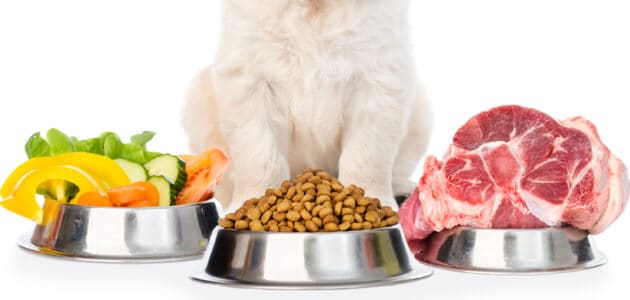
Owning a dog is a lifelong commitment, and it requires constant love, care, and attention. While this means guaranteed snuggles and lots of fun, it also means ensuring that your dog’s needs are being met. One of the most important components in this process is providing your pooch with a varied, satiating, and nutritionally satisfying diet.
If you personally prefer organic foods and appreciate the health and environmental benefits, you may also be interested in incorporating organic foods into your dog’s diet. While this may seem simple enough, finding high-quality organic dog food is not always straightforward. With no official governing body for organic dog food production, labeling for organic pet products can often be confusing and, at times even misleading.
While the research and buying process may be a little more complicated, the benefits of organic dog food are clear. If you’re someone who advocates for a more holistic lifestyle, incorporating organic foods into your dog’s diet will not only ensure your pooch is getting all their essential nutrients, vitamins, and minerals, it’ll also reduce your dog’s exposure to pesticides, fertilizers, and GMOs.
- Features to Consider in Good Organic Dog Food
- Top 10 Best Organic Dog Foods 2025
- 1. Best Overall Organic Dog Food: Castor and Pollux Organix Butcher & Bushel
- 2. Best Budget Organic Dog Food: Newman’s Own Chicken and Liver Dinner for Dogs
- 3. Best Organic Dog Food for Puppies or Small Breeds: Castor and Pollux Organix Puppy Recipe
- 4. Best Premium Organic Dog Food: The Honest Kitchen Whole Grain Dog Food
- 5. Best Organic Dog Food for Dogs With Allergies: Lily’s Kitchen Proper Dry Organic Dog Food
- 6. Best Organic Dog Food for Senior Dogs: Castor and Pollux Organix Senior Recipe
- 7. Best Grain-Free Organic Dog Food: Ziwi Peak Air-Dried Dog Food
- 8. Best Organic Wet Dog Food: Lily’s Kitchen Organic Chicken Supper
- 9. Best Natural Dry Dog Food: The Honest Kitchen Whole Food Clusters
- 10. Best Natural Dog Food for Medium/Large Dogs: Blue Buffalo Life Protection Formula
- Guide to Buying the Best Organic Dog Food
- How Does Organic Dog Food Differ From Regular Dog Food?
- Organic Certification and Labelling
- Benefits of Using Organic Dog Food
- Types of Organic Dog Food: Wet or Dry?
- Commonly Used Ingredients in Dog Food
- Are Grains Bad for Your Dog?
- Breaking Down Dog Food Terminology
- Best Organic Dog Food 2025: Top 5 Frequently Asked Questions
- Final Thoughts
Features to Consider in Good Organic Dog Food
Before jumping straight into the best organic dog foods on the market, it’s important to consider what qualities make a good organic dog food. If you find yourself feeling befuddled by all the different dog food jargon, you can consult our handy organic dog food terminology guide.
With so many different certifications, product variants, and ingredients, it can be difficult to know which type of organic dog food is right for your pooch. To give you a better idea of how these ingredients and regulations all fit together, we’ve put together a brief guide to what we believe are the three most important things to remember when buying organic dog food.
Ingredients
Every dog is different, so knowing what ingredients make up your dog food will help to ensure you’re meeting the specific nutritional needs of your pet. Generally speaking, most organic dog foods are made up of a mixture of protein, carbohydrates, water, vitamins, and minerals — this is standard across both wet and dry dog food. If a pet food product is labeled as organic, it means that its ingredients are grown without the use of pesticides or fertilizers, growth hormones, or antibiotics.
Below is a brief breakdown of the basic constituents of most dog food products:
- Protein: The type of protein used in dog food will depend on the price and intended flavor of the product. The most common proteins are poultry, livestock, or seafood. Animal byproducts may also be included for additional protein; this usually includes carcass parts, organs, blood, or meat broth.
- Carbohydrates: When it comes to dog food, carbohydrate content typically comes by way of one or more grain products. Some common grains used in dog food are corn, wheat, soybean, and barley. You may also encounter grain alternatives like potatoes or peas.
- Other: In order to better meet your dog’s nutritional needs, organic dog food may be fortified with additional vitamin and mineral content (i.e., added Omega-3 or Omega-6).
Certification
While you’d be forgiven for thinking that organic certification is a simple enough topic, the complexity of regulatory restrictions and industry marketing tactics means that organic product labeling is rarely straightforward.
As there is no governing body for the production of organic dog food, animal food companies follow the same basic organic certification principles that are applied to human food by the United States Department of Agriculture (USDA). In lieu of more concrete pet food guidelines, the USDA has specified that use of the USDA organic certification seal is only permitted for products that are made up of at least 95% organic ingredients.
For more information on USDA food certification, take a look at our breakdown of organic certification and labeling for dog food.
Dry vs. Wet Food
Another important factor to consider when purchasing organic dog food is whether your dog prefers wet or dry food. While your personal mileage may vary, neither variety of dog food is uniquely better than the other, and many owners like to feed their dog a mixture of both in order to keep their diet interesting and nutritionally varied. However, if your dog is a fussy eater, you may want to opt for one type of dog food over the other.
In most cases, the best way to determine which type of food your dog prefers will be through trial and error. Fortunately, many veterinary clinics and pet shops offer small sample pouches of dog food. Trialing a few of them will not only help you determine what your dog likes; it’ll also save you from spending a fortune on food that may not be eaten.
With so many factors to consider, selecting the best organic food for your dog can be a tricky and time-consuming process. Now that you know exactly what you need to find the perfect food for your pooch, let’s take a look at the best options on the market today.
Top 10 Best Organic Dog Foods 2025
1. Best Overall Organic Dog Food: Castor and Pollux Organix Butcher & Bushel
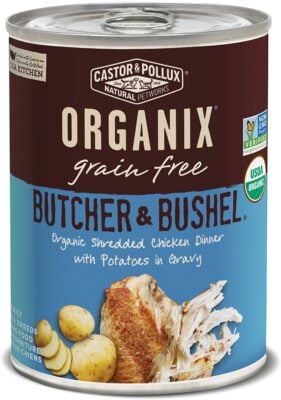
Editor’s Rating:
Why we like it: Made up of hearty chunks of real organic meat and vegetables, this wet food can win over even the fussiest of eaters.
Quick Facts:
- Certified Organic: Yes
- Grain-Free: Yes
- Wet/Dry: Wet
- Flavors: Shredded chicken & potato, turkey with carrot & sweet potato, chicken wing & thigh with sweet potato, turkey & chicken liver with peas, and chicken & potato with apple
Castor and Pollux’s Butcher and Bushel Organix range is the perfect alternative for dogs that aren’t interested in dry food. When it comes to feeding your dog wholesome, filling ingredients, it doesn’t get much better than whole chunks of meat, vegetables, and gravy. Not only does this food have a chunky, meaty texture (great for dogs who prefer the texture of raw ingredients), it’s also USDA-certified organic and free from nasty pesticides and synthetic chemicals.
Available in a wide range of white meat flavors, there’s something here to please dogs of all sizes, ages, and diets. The only real downside to consider is the absence of red meat flavor options.
Not that the chicken wings and chicken thighs incorporated into this food are pressure cooked with the bones in. This means that you may find soft bone bits mixed in with the meat. While this may seem alarming, the bones are completely safe for your dog to consume. In fact, due to the added nutritional content from bone marrow, dog food with bone bits is often a healthier option for your pet.
Alternatively, if your dog is picky or sensitive to bone bits, you can simply select from other boneless flavors or even check out another strictly boneless product, such as Lily’s Kitchen Organic Chicken Supper.
Pros
- USDA certified organic ingredients
- Chunky, meaty texture
- Huge range of favor options
Cons
- No red meat options
2. Best Budget Organic Dog Food: Newman’s Own Chicken and Liver Dinner for Dogs
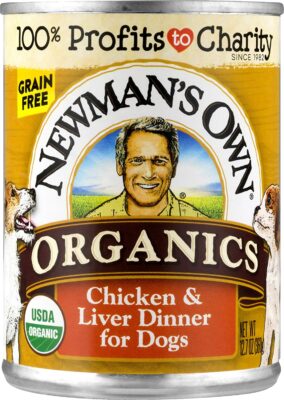
Editor’s Rating:
Why we like it: At less than a dollar an ounce, Newman’s Own Chicken and Liver Dinner for Dogs are one of only a handful of budget-friendly dog foods that is both grain-free and USDA certified organic.
Quick Facts:
- Certified Organic: Yes
- Grain-Free: Yes
- Wet/Dry: Wet
- Flavors: Chicken & liver
Providing your dog with a nutritionally balanced, organic diet doesn’t have to cost you an arm and a leg. Newman’s Own Organic Chicken and Liver Dinner For Dogs is made up of nourishing whole ingredients, with the main ingredients being organic chicken, organic chick broth, and organic liver. This paté style wet food is ground smooth, making it a great option for dogs who struggle with structured foods, like puppies, small dogs, and elderly dogs).
What’s more, thanks to the generosity of founder Paul Newman, Newman’s Own has committed 100% of its profits to animal welfare charities. This means that your purchase will be directly contributing to charities like Fidelco Guide Dog Foundation and the Search Dog Foundation.
If your pooch is sensitive to grains, you’ll also be happy to know that this formula is free from wheat and corn. In fact, the only real disadvantage to this organic dog food is the limited flavor variety.
If you do need a wet food with more flavor variety, it’s hard to look past our pick for the best overall organic dog food.
Pros
- USDA certified organic ingredients
- Great value per ounce
- Your purchase supports animal welfare charities
Cons
- Limited flavor variety
3. Best Organic Dog Food for Puppies or Small Breeds: Castor and Pollux Organix Puppy Recipe
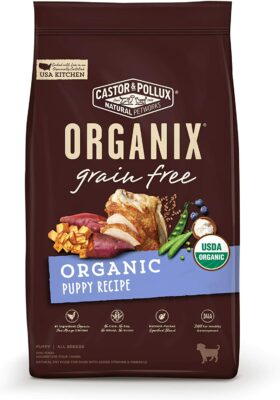
Editor’s Rating:
Why we like it: Packed with superfoods, Castor and Pollux’s Organix Dry Puppy Food is overflowing with all the essential vitamins, minerals, and nutrients your puppy needs to grow strong and healthy.
Quick Facts:
- Certified Organic: Yes
- Grain-Free: Yes
- Wet/Dry: Dry
- Flavors: Chicken & sweet potato
With nourishing ingredients like organic flaxseed, chicken, blueberries, and sweet potato, it’s easy to see why Castor and Pollux is a leader in the organic dog food market. Like any baby, puppies need a little extra care when it comes to their diet. Luckily, Castor and Pollux’s Organix Dry Puppy Food is filled with tons of healthy, filling ingredients, giving your pup the best chance to grow up strong and healthy.
As if the USDA certification wasn’t enough to set this kibble apart from other natural dog foods, it’s also fortified with essential fatty acids, including docosahexaenoic acid, an anti-inflammatory Omega-3 fatty acid that is crucial for early brain development and heart health.
Finally, you can relax knowing that this kibble is free from grains, synthetic fertilizers, pesticides, and antibiotic raised chickens. If you require top-quality dry food for a small breed dog, Castor and Pollux offer a similar formula with added probiotics and prebiotics for maintaining your dog’s health. Unfortunately, this product is only available in a 4lb bag, which may or may not be as cost-effective as larger quantities in the long run.
Alternatively, if you need a dog food suitable for large breeds, take a look at the Blue Buffalo Life Protection Formula for Large Breeds.
Pros
- USDA certified organic ingredients
- Fortified with essential fatty acids
- Small breed variant available
Cons
- Small breed variant is only available in 4lb bags
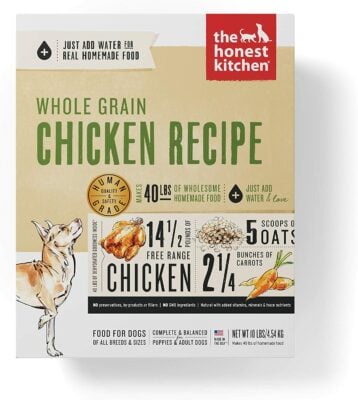
Editor’s Rating:
Why we like it: Not only does this dehydrated whole grain dog food provide a wholesome diet for your pooch, but it will also save you room in your fridge and your cupboard — just add water!
Quick Facts:
- Certified Organic: No
- Grain-Free: No
- Wet/Dry: Wet
- Flavors: Chicken, turkey, and beef
The Honest Kitchen has built its reputation around honest, wholesome animal food products, and this whole grain recipe is no exception. While this product is not USDA certified organic, it is labeled as having natural, organic ingredients. This means the product contains at least three organically grown ingredients, ranging from flaxseed and barley to oats and kelp. Available in three different meat varieties, The Honest Kitchen can accommodate to suit even the fussiest of eaters.
As this food is dehydrated, you’ll need to add water before serving. While this may seem like extra work, it actually increases the shelf life of your pet food and minimizes the space you need in your cupboard or fridge to store your pet food. An added bonus is that The Honest Kitchen can decrease their carbon footprint, reduce packaging, and use less water when producing dehydrated food, making their product much more environmentally friendly.
Unfortunately, despite its premium price point, The Honest Kitchen’s Dehydrated Organic Whole Grain Dog Food is only suitable for adult dogs. If you need a more affordable dog food option that’s also suitable for puppies, consider Newman’s Own Dinner for Dogs.
Pros
- Contains organic ingredients
- Requires minimal storage space
- Climate pledge friendly
Cons
- Ingredients are not USDA certified organic
- Not puppy friendly
5. Best Organic Dog Food for Dogs With Allergies: Lily’s Kitchen Proper Dry Organic Dog Food
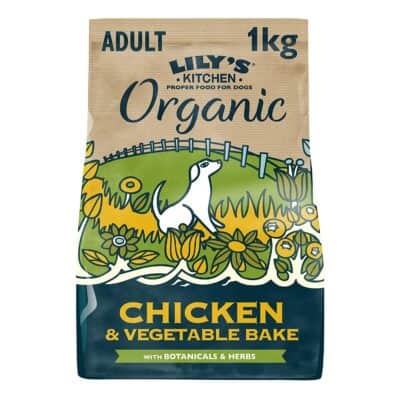
Editor’s Rating:
Why we like it: Packed with gentle, specialized botanical ingredients, this dry dog food is gentle on dogs with allergies and sensitive constitutions.
Quick Facts:
- Certified Organic: No
- Grain-Free: No
- Wet/Dry: Dry
- Flavors: Chicken & vegetable bake
There is mounting evidence that certain non-organic pet food ingredients can act as a catalyst for allergies and ongoing health issues in dogs. Containing wheat-free, hypoallergenic botanical ingredients, Lily’s Kitchen’s Proper Dry Organic Dog Food is the ideal dry food for dogs with allergenic skin or sensitive tummies. These ingredients, which include chickweed, rosehip, and milk thistle, are packed with anti-inflammatory properties and high levels of antioxidants, helping to soothe irritated skin and calm sensitive tummies.
Manufactured in the European Union, this dry kibble has not been certified by the USDA. However, this product is still 100% organic. This means there are no nasty chemicals, pesticides, or fertilizer residues to trigger an allergic reaction in your dog’s tummy or on its skin.
If you need dog food that’s attuned to skin sensitivities but want more flavor variety, take a look at the Ziwi Peak kibble from New Zealand.
Pros
- Hypoallergenic botanicals
- 100% organic ingredients
- Wheat-free
Cons
- Limited flavor variety
- Not officially USDA certified organic
6. Best Organic Dog Food for Senior Dogs: Castor and Pollux Organix Senior Recipe
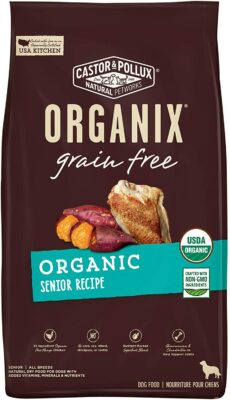
Editor’s Rating:
Why we like it: Formulated with vitamins, minerals, and anti-inflammatory ingredients, this senior food formula will provide superb nutritional support for your dog throughout its twilight years.
Quick Facts:
- Certified Organic: Yes
- Grain-Free: Yes
- Wet/Dry: Dry
- Flavors: Chicken & sweet potato
With wholesome organic ingredients, including real chicken, blueberries, and salmon oil, Castor and Pollux’s Organix Grain-Free Senior Recipe Food delivers your dog a nourishing superfood diet to ease the aches and pains of old age. This formula from Castor and Pollux contains guaranteed levels of glucosamine and chondroitin — both of these sugars are vital in maintaining your dog’s cartilage health, ligament sponginess, and joint lubrication.
As with the entire Castor and Pollux Organix range, there are no pesticides, synthetic fertilizers, GMO-ingredients, or artificial colors and preservatives in this formula. Unfortunately, this product is currently only available in one flavor. Therefore, if your dog is sensitive to chicken, this option may not be right for you.
In most cases, Castor and Pollux’s Organix Grain-Free Senior Recipe Food would be fine for a puppy, however, using a puppy-specific dog food is a safer and more efficient way to ensure that your pup is getting the right kinds of nutrients for healthy growth and development. For a top-rated organic dog food for puppies, check out Castor and Pollux’s Organix Puppy Food.
Pros
- Ingredients for joint support
- USDA certified organic ingredients
- 100% grain-free
Cons
- No red meat options
- Limited flavor variety
7. Best Grain-Free Organic Dog Food: Ziwi Peak Air-Dried Dog Food
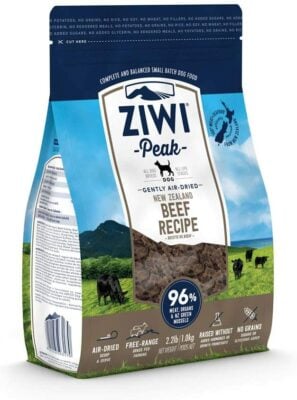
Editor’s Rating:
Why we like it: Rather than loading up this kibble with filler grains or carbohydrates, Ziwi Peak packs each packet of dry food with raw chunks of whole, air-dried protein.
Quick Facts:
- Certified Organic: No
- Grain-Free: Yes
- Wet/Dry: Dry
- Flavors: Beef, chicken, lamb, tripe & lamb, venison, and mackerel & lamb
Given its country of origin, this product hasn’t been certified as organic by the USDA. However, this New Zealand-based company only uses sustainable and ethically sourced ingredients in their products and would most likely be considered a 100% organic animal product on the US market.
Each packet of Ziwi Peak kibble contains up to 96% meat products, animal organs, and New Zealand green mussels without any added grains, chemicals, or antibiotics. All the meat products used are free-range, grass-fed, and free from genetic modification.
Packed with naturally available nutrients, vitamins, and minerals, this dog food can act as both a complete meal and a meal topper to add a boost to your dog’s current diet. Given the high number of micronutrients in each kibble biscuit, Ziwi Peak can also be soothing for dogs with skin allergies.
Ziwi Peak’s specialized slow air-drying technique allows for maximum nutrient preservation in each piece of kibble, removing the risk of harmful bacteria on raw meat. Despite being an air-dried product, Ziwi Peak food isn’t dehydrated, so you don’t have to worry about adding water to each meal.
If your dog is sensitive to air-dried food, Lily’s Kitchen Proper Organic Dry Food is a similarly great alternative.
Pros
- Sustainable and ethically sourced meat
- 96% meat, organs, and New Zealand green mussels
- 100% grain-free
Cons
- Ingredients are not USDA certified organic
8. Best Organic Wet Dog Food: Lily’s Kitchen Organic Chicken Supper
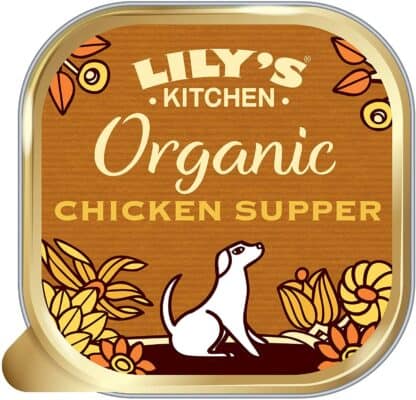
Editor’s Rating:
Why we like it: Made from only organic ingredients and bursting with added dietary fiber, this wet food is a nourishing option for dogs with sensitive digestive systems.
Quick Facts:
- Certified Organic: No
- Grain-Free: No
- Wet/Dry: Wet
- Flavors: Chicken, pork, and turkey & spelt
Manufactured in the United Kingdom, Lily’s Kitchen Organic Chicken Supper contains 100% organic, whole ingredients. Made with real chicken, pork, and turkey, as well as natural botanicals like spirulina, kelp, and alfalfa, your dog is guaranteed to receive a completely balanced meal with every serving. The addition of botanicals also reduces the chance of this dog food triggering allergies or reactive skin disorders.
Packed with dietary fiber from the spelt, peas, and pork, this product provides relief for dogs that suffer from constipation or digestive issues. In addition to being wheat-free, Lily’s Kitchen Organic Chicken Supper does not contain soy or corn. In order to make up the deficit in micronutrient content, Lily’s Kitchen has fortified this product with several essential amino acids, including L-carnitine, zinc chelate, and ferrous chelate.
If you’re looking for something similar to Lily’s Kitchen Organic Chicken Supper but with more flavor variety, check out Ziwi Peak Air-Dried Dog Food.
Pros
- 100% organic
- Allergy-friendly
- Assists digestion
- Fortified with amino acids
Cons
- Limited flavor variety
- Ingredients are not USDA certified organic
9. Best Natural Dry Dog Food: The Honest Kitchen Whole Food Clusters
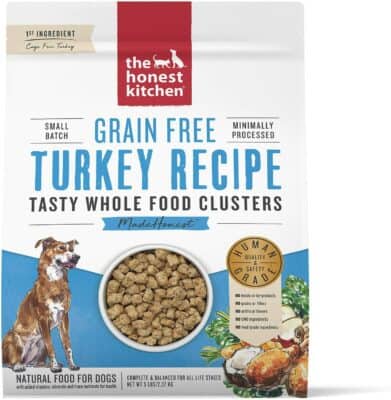
Editor’s Rating:
Why we like it: Instead of creating another generic kibble product, The Honest Kitchen has pivoted to whole food clusters, maximizing texture and taste without cutting back on nourishing nutritional content.
Quick Facts:
- Certified Organic: No
- Grain-Free: Yes
- Wet/Dry: Dry
- Flavors: Beef, chicken, and turkey
With these tasty whole food clusters, The Honest Kitchen has created what is arguably the world’s first human-grade dry dog food. Made with clean, whole-food ingredients like flaxseed, coconut oil, and cage-free or ranch-raised meat, this dry kibble is legally considered a natural dog food. While The Honest Kitchen is still pursuing that elusive USDA organic certification, you won’t find any meat fillers or animal byproducts in these whole food clusters.
Although this is a grain-free formula, it doesn’t skimp out on essential nutrients. Vibrant vegetables offer antioxidants, while naturally sourced ingredients like apple and pumpkin aid digestion and balance gut health. What’s more, these crunchy clusters are designed to help prevent the build-up of plaque, keeping your dog’s mouth looking and smelling fresh and minimizing the need for expensive dental interventions at the vet.
Please note, The Honest Kitchen’s clusters may be too hard for dogs with missing teeth or senior dogs. If you need a more sensitive food formula, check out Castor and Pollux’s Organix Senior Dogs Range.
Pros
- Dry clusters support doggy dental health
- Packed with superfood ingredients
- 100% grain-free
Cons
- Ingredients are not USDA certified organic
- Clusters may be too hard for senior dogs
10. Best Natural Dog Food for Medium/Large Dogs: Blue Buffalo Life Protection Formula
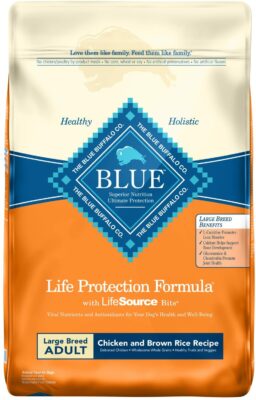
Editor’s Rating:
Why we like it: Packed with ingredients that optimize joint health and mobility, Blue Buffalo’s Large Breed formula will help your dog enjoy a more mobile and comfortable life.
Quick Facts:
- Certified Organic: No
- Grain-Free: No
- Wet/Dry: Dry
- Flavors: Chicken & brown rice, fish & oatmeal, and lamb & brown rice
Feeding a large breed dog is hard work, mostly because you need to make sure they’re getting all the right nutrients, vitamins, and minerals to keep them full throughout the day and healthy throughout the year. The Blue Buffalo large breed formula contains everything your dog needs to feel full while also supporting their joints and improving their mobility. The ingredients, which include real chicken, blueberry, peas, cranberry, and flaxseed, are cold-formed, ensuring that the kibble retains all the hearty micronutrients and potent antioxidants.
Large breed dogs are more likely to experience arthritis or other mobility issues due to their larger weight and size. Two ingredients in this formula, glucosamine, and chondroitin, have proven benefits for large breed dogs who may be at risk of developing these conditions. These two sugar compounds will draw water into your dog’s leg and hip sockets, alleviating stiffness and maintaining sponginess and lubrication around the joints.
If you’re in need of dog food for smaller breeds, check out the puppy and small dog food range from Castor and Pollux.
Pros
- Contains glucosamine and chondroitin
- Cold-formed kibble
- Range of flavor options
Cons
- Ingredients are not USDA certified organic
Guide to Buying the Best Organic Dog Food
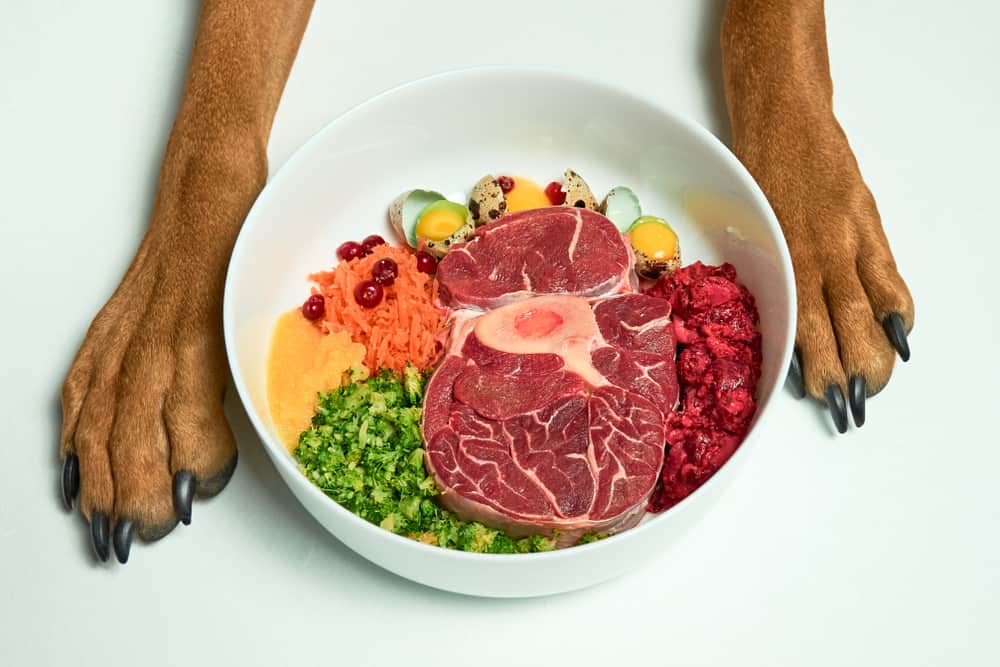
Deciding on the best organic dog food for your pet can be difficult, especially when there are so many different options. To help you pick the most suitable organic dog food for your pet, we’ve put together this handy guide to help you in selecting an organic food for your dog.
Don’t worry, everything you need to know about organic dog food, from the most commonly used ingredients to the truth about grains in dog food is covered in this guide.
How Does Organic Dog Food Differ From Regular Dog Food?
Organic dog food only differs from regular dog food in the type of ingredients that are used and how these ingredients are grown. Organic dog food will only use ingredients that are grown, raised, harvested, and processed organically; this means without the use of pesticides, growth hormones, antibiotics, synthetic fertilizers, and genetic modification. Currently, pet food companies can only label their dog food as certified organic if their ingredients meet the same USDA guidelines that are applied to human food products. Countries that produce dog foods outside of the US are subject to slightly different guidelines.
Organic Certification and Labelling
In order to classify and advertise dog food products as organic, companies must adhere to both USDA meat and poultry regulations and FDA non-meat regulations and pet food labeling guidelines. These regulations ensure that any product labeled as ‘organic’ must contain at least 95% organic ingredients.
For this reason, certified organic dog food is more difficult to come by and generally more expensive than non-organic dog food. Unfortunately, many dog food products that claim to be organic are only partially composed of organic ingredients. To help clarify what USDA certification actually means when it comes to dog food, we’ve listed the key certification guidelines below:
- If the product is made up of 100% organic ingredients, the producing company can display the USDA seal and claim “100% organic” on the packaging.
- If the product is at least 95% organic (excluding salt and water), the company can display the USDA seal.
- If the product contains at least 70% organic ingredients, the company can list three of those ingredients on the front of the package and claim that the product is “made with organic ingredients.”
- If the product contains less than 70% organic ingredients, the company is not permitted to list the ingredients on the front of the product but can list them in the nutritional information panel. This product cannot legally describe itself as organic and is prohibited from using the USDA seal.
If you’re set on getting a USDA certified organic food for your dog, your best bet is Castor and Pollux’s Organic Butcher & Bushel Grain-Free Dog Food.
Benefits of Using Organic Dog Food
While the organic movement may be heavily debated around the dinner table, the scientific community is of the firm opinion that organic food is not only beneficial for the environment, but also for the health of your dog. To help you understand why we’ve listed four science-backed benefits of organic food:
- Higher nutrient levels: Organic foods will often contain higher levels of nutrients and antioxidants. This is particularly true for beneficial nutrients like Omega-3, an anti-inflammatory fatty acid that is known to help reduce hardened arteries. When vegetables are sprayed with pesticides and fertilizers, fatty acids like Omega-3 are produced in lesser quantities.
- No toxic additives: Organic dog foods are less likely to contain any of the toxic additives that trigger health issues or contribute to ongoing health concerns in dogs (i.e., osteoporosis or seizure). These additives include GMOs, synthetic growth hormones, antibiotics, artificial flavors, artificial preservatives, and artificial colors.
- Better for the environment: Not only is organic food better for your pet’s health, but it is also a more responsible choice for the environment. Organic foods are grown without harmful pesticides or fertilizers, promoting greater biological nutrient recycling, and minimizing the chemical run-off into nearby waterways.
- Better Taste: As organic food is grown without the use of toxic additives, organic products tend to have a more natural taste and scent. If your dog is a picky eater, the more natural taste of organic foods can be a gamechanger.
Types of Organic Dog Food: Wet or Dry?
Unless your dog has specific dietary requirements or they’re a finicky eater, it is advised to give your dog a mixture of both wet and dry food. Offering both varieties allows your pet to reap the maximum benefits that each food type has to offer. Read on for a brief breakdown of the respective pros and cons of wet and dry dog food.
Wet Food
Wet food refers to any type of pet food with high moisture content. Typically sold in cans or pouches, wet food is usually served as a pate style, with the protein, fat, and carbohydrates blended into a smooth, jelly-like consistency. While this can be more appetizing for dogs, wet texture food will not stimulate your dog’s teeth and jaw muscles. As a result, a predominantly wet food diet can contribute to dental issues or odorous oral hygiene.
At a glance, the benefits of wet food include:
- More easily digested
- More meaty texture/taste
- High moisture content (i.e., improved hydration)
- Long shelf-life
As well as being more palatable, wet food is also more easily digestible, making it a great option for fussy dogs or dogs with food sensitivities. One of the best organic wet dog foods on the market today is Castor and Pollux’s Organic Butcher & Bushel Grain-Free Dog Food.
Dry Food
Dry dog food, also known as kibble, comes in the form of crunchy biscuits or pods. There are many different types and sizes of kibble available on the market, making it highly customizable for anything from a large meal to a small snack. If you own a smaller pooch, opt for mini kibble biscuits to ensure your dog is able to easily eat and digest their meals.
At a glance, the benefits of dry food include:
- Reduces plaque/tartar build-up
- Reduces bad breath
- Doesn’t require refrigeration
- Can be left out throughout the day
- Cheaper than wet food
Beyond these benefits, kibble is also linked to superior oral health in dogs. The crunchy texture of kibble helps to break off plaque or tartar build-up on the teeth, keeping your dog’s mouth and breath fresher for longer between veterinary visits.
Dry food also tends to be more affordable than wet food as it contains a higher percentage of water. Note that, while this may be good for your wallet, it does mean that the food contains less protein and solid food ingredients.
For top-quality natural dry food, we recommend The Honest Kitchen’s Whole Food Clusters.
Commonly Used Ingredients in Dog Food
Whether you use wet or dry food, all dog food is made up of a mixture of ingredients that are formulated to meet their nutritional needs. Generally, this means that most dog foods will include meat and meat byproducts, vitamins, minerals, cereals, and grains.
The type of meat used in dog food will vary depending on the flavor of the product you purchase. Meats commonly used in pet food include livestock, horse, poultry, or seafood. Animal byproducts, such as organs, carcass parts, and cheek meats, may also be used.
If you choose to buy pet food that contains grains, this will usually consist of soybean, cornmeal, barley, or wheat. These ingredients can then be mixed with water, salts, meat broth, blood, and sometimes preservatives and flavoring if the pet food is not organic or natural.
Alternatively, if you decide to use a grain-free pet food, your ingredient list will generally include food items like potato, sweet potato, or peas to ensure that your pet is getting enough carbohydrates.
If you’re on the hunt for a top-rated grain-free dog food, take a look at Ziwi Peak’s Air-Dried Dog Food.
Are Grains Bad for Your Dog?
While it is a common belief that grain foods are bad for pets, what limited evidence there is for this position has been largely dismissed by the broader veterinary community. Many dogs can reap the nutritional benefits from grains without having any adverse reaction.
In fact, including an appropriate amount of carbohydrates from grains in your dog’s diet is important in maintaining healthy skin and hair, as well as a strong immune system. A great dog food that includes grains is The Honest Kitchen’s Organic Whole Grain Dehydrated Wet Food.
That being said, some dogs can have an allergic reaction to certain types of grains. However, this type of allergy is present in less than 1% of dogs. If you think your pet may be allergenic, the best thing to do is to speak with a veterinarian. There are plenty of grain-free options available for dogs with grain allergies that still provide all the essential nutrients that your pet needs.
If you have been feeding your dog grain-free food and you’re worried they may not be getting enough carbohydrates, don’t panic! Most grain-free dog foods use alternative carbohydrate sources (i.e., potato or peas) to ensure your dog is consuming a balanced meal.
Breaking Down Dog Food Terminology
The confusing labeling between natural and organic dog foods is often what turns people off from using organic products. In an attempt to rectify this situation, we’ve listed some of the most commonly used dog food terminology to make understanding different labeling a breeze.
- Corn/grain-free: Corn or grain-free dog food refers to food products that do not contain corn, wheat, rice, or other grains.
- Kibble: Kibble is the shorthand term for the biscuits that make up dry dog food. Kibble bags come in a range of sizes, meaning they can accommodate both small and big dog breeds.
- Wet food: Usually manufactured in tins or pouches, wet food refers to a mixture of meat chunks and sauce. Wet food products are sold in either whole chunks or pate form.
- Complete nutrition: If a dog food product states that it contains complete nutrition, this implies that the food has all the essential vitamins and minerals your dog needs.
- Organic: A popular classification, organic food uses ingredients that are grown without pesticides, antibiotics, fertilizers, or GMOs.
Best Organic Dog Food 2025: Top 5 Frequently Asked Questions
-
What Makes Dog Food Organic?
Dog food can be classified as organic if between 95% and 100% of its ingredients are grown or raised without the use of pesticides, antibiotics, growth hormones, synthetic fertilizers, or genetic modifications.
-
Is Organic Dog Food Healthier for My Dog?
Strictly speaking, there is little to no difference in nutritional value between organic and non-organic dog food products. A non-organic dog food can still give your dog all the essential vitamins and minerals it needs to be healthy. Nevertheless, it is widely believed that organic pet food is still a healthier option, largely due to the reduced exposure to toxic pesticides, harmful growth hormones, and allergenic additives.
-
Is Dry or Wet Food Better for Dogs?
Whether you buy wet or dry food will ultimately come down to your dog’s health requirements and dietary preferences. Many pet owners prefer to buy wet food as it has a more natural texture and contains more visible ingredients (such as vegetables and meat chunks). However, some dogs will only eat dry kibble, which is still a great option, especially if your dog has dental issues, digestive problems, or allergenic sensitivities. At the end of the day, unless your dog is opposed to one option or the other, there is no reason why you can’t feed your dog both wet and dry food. If you’re looking for some dehydrated options, check out a list of our favorites here.
-
Can I Make My Own Organic Dog Food?
Yes, you can make your own organic dog food by purchasing regular organic produce from your supermarket or greengrocer. While this will ensure that you know exactly what ingredients are going into your dog food, it’s imperative that you’re making safe and nutritionally balanced meals.
If you’re set on making your own organic dog food at home, make sure to consult your vet first. Your vet will be able to give you a better idea of what sort of foods you should include in each meal, as well as any foods to avoid. It is especially important to consult your vet if your dog has a sensitive stomach, allergies, or any other medical conditions.
-
Are Organic and Natural Dog Foods the Same?
There are a few differences between dog foods labeled natural and dog foods that are labeled organic. More often than not, organic dog foods can also be labeled as natural, meaning they contain unprocessed and unrefined ingredients.
Note that unlike USDA certified organic dog food, there is no legal definition for “natural dog food.” This means that any company can label their product as natural, so be sure to thoroughly read the ingredients list if you’re considering a natural dog food for your pet.
Final Thoughts
While the research process may take a little longer, the bottom line is that investing in an organic dog food is an investment into your dog’s health and future. Nevertheless, if you have any concerns about incorporating a new food into your dog’s diet, just ask your veterinarian about introducing new foods to your dog




